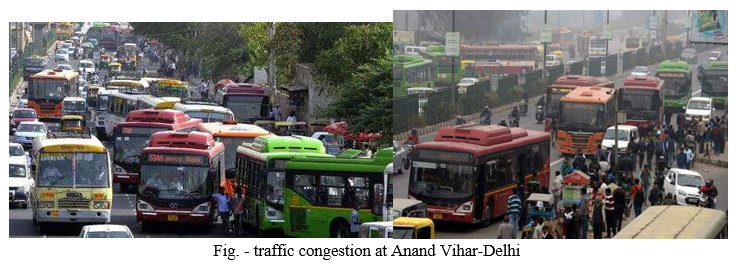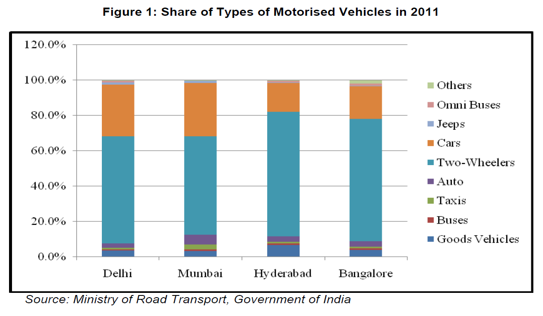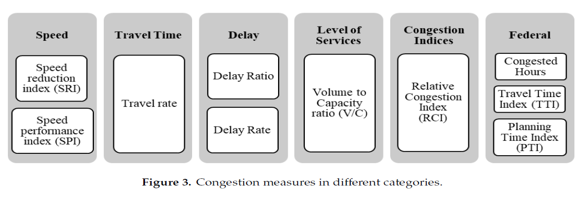Ijraset Journal For Research in Applied Science and Engineering Technology
- Home / Ijraset
- On This Page
- Abstract
- Introduction
- Conclusion
- References
- Copyright
Traffic Congestion Analysis using PTV VISSIM Software
Authors: Anuj Kumar Atrish , Gaurav Sonal Bhugra
DOI Link: https://doi.org/10.22214/ijraset.2022.40370
Certificate: View Certificate
Abstract
The traffic condition in third world countries like India on urban road pose serious problem . The high increase in number of vehicles on road and increasing urbanization leads to problem of congestion, which further leads to complication and hazard on the cities road. Indian city already suffering in terms of infrastructure as well as operational efficiencies. Considering the regulation and infrastructure gap on city road this paper first describe the factor causing the congestion on the city road and after that present some recommended measure like rationalize the design of road, implementation the regulation for road users.
Introduction
I. INTRODUCTION
Traffic congestion is a condition in transport that is characterized by slower speeds, longer trip times, and increased vehicular queuing. Traffic congestion on urban road networks has increased substantially, since the 1950s.[1] When traffic demand is great enough that the interaction between vehicles slows the speed of the traffic stream, this results in some congestion. While congestion is a possibility for any mode of transportation, this article will focus on automobile congestion on public roads.
Most of the cities are undergoing multifaceted problem because of rapid urbanization [1]. Traffic congestion is one of the intolerable problems of urban area emerging due to sudden increment in the private transport, affecting urban society, economy [1]. The conventional as well as traditional approach construct new road is a temporary relief but it does not work always for variety of reason like political, environment, financial, moreover it may encourage the growth of new vehicles and forced occupancy [1, 3].Traffic congestion is a global issue that challenges the development of a resilient and sustainable transportation system. The long-term goal of this research paper is to contribute to the development of a sustainable and resilient transportation management system that aims to minimize the negative socio-economic-environmental impact of congestion.
Traffic congestion is an extensive global phenomenon resulting from high population density, growth of motor vehicles and their infrastructure, and proliferation of rideshare and delivery services [8].
Researchers have defined congestion from different perspectives. The most common definition of congestion in the state of traffic flow is when the travel demand exceeds road capacity [9]. From the delay-travel time perspective, congestion occurs when the normal flow of traffic is interrupted by a high density of vehicles resulting in excess travel time [10]. According to the United States Department of Transportation Federal Highway Administration (DOT-FHWA), nonrecurring congestion contributes to more than 50% of all traffic congestion, where 40% of congestion is caused by recurring congestion [10]. Congestion can also be defined by the increment of the road user’s cost due to the disruption of normal traffic flow [12]. A variety of reasons are responsible for creating congestion in most urban areas. Depending on these different reasons, congestion can be classified into recurring and nonrecurring congestion. Recurring congestion occurs regularly, mostly due to the excessive number of vehicles during peak hours [11]. In order to ensure a sustainable and resilient transportation system, multi-disciplinary mitigation actions on combating road traffic congestions are necessary [19]. For many years, multifold attempts from the government, public, and private sector policy-makers, researchers, and practitioners have been implemented to minimize losses due to congestion [20–22]. It is observed that proper monitoring of the traffic condition is the first step to building an effective traffic control management system [23–26]. By doing so, the congestion levels can be quantified promptly, and preventive actions can be initiated before the peak of the congestion hours. Measuring probable congestion can also be beneficial while planning for traffic management during special events [27].
II. LITERATURE REVIEW
The main objective of the study is to identification the actual cause behind the congestion and provided the practical solutions for Indian traffic to reduced congestion. This paper is generated on the basis of primary and secondary data. The first step selecting the indicator to highlight the congestion that is the flow diagram, and snapping the images. To carry out primary data the data has been collected through survey method-counting the vehicles movements.
A. Evidence of Congestion

B. Cause of Congestion
The traffic congestion is a situation on road networks when physical uses of road by vehicles increases .It occurs when road network are no longer capable to accommodating the volume of movements that used by them and it is characterized by slow speed, long trip timing and high vehicular queuing.[4]
- Increasing growing population in Indian cities rapidly growing population by birth and migration facing an unexpected congestion on road. Better facilities like-communication system, medical facilities, ducational institution leads to heavy traffic.
- Insufficient infrastructure: Insufficient infrastructure is one of the most significant reasons for congestion, especially in highly populated areas. Because of the higher population rate, the number of vehicles also increases with it. When the existing number of infrastructures fails to occupy this increasing number of cars, congestion occurs [17].
- Variation in traffic flow: The variability in day-to-day traffic demands results in higher volumes in some days compared to others. When these variable demands do not match with the fixed capacity, a delay may occur [18]
- Improper planning of Road pattern and network.
- Forced occupier the retailer forcedly set up their business along main city road or bus road and pavements causing narrowing the road.
- Random parking the illegal and random parking on main road is common habits of drivers and riders, causing unexpected congestion any time. Fig. occupancy by business shops on the road
- Irregular public transport Irregularity of public transport courage the people to depend on private vehicles.
- Increasing rent Increasing rent within short distance of public transport is one the of the reason to depend on private vehicles.
- In most metropolitan cities, travelers experience congestion every day during daily peak hours. According to FHWA, roughly half of the congestion experienced by traffic users is recurring [11].
C. Impact Of Congestion
Road traffic jam is a major problem in most cities in India, due to poorly planned road network, presence of small critical area which is common hot spot for congestion [5]. There are some effects of congestion listed here:
- Congestion means just waste of valuable time. The wasted time could effectively used in productive work.
- The slowing speed vehicles or sudden stop and go driving pattern in traffic leads to more fuel consumption resulting emission of pollutant gas.[1]
- The noise pollution has proportionate relation to traffic congestion. In office time hour it crosses 90dB, harmful to our health.
- Analytics in 2017, over the next 10 years, the most congested 25 cities of the U.S. are estimated to cost the drivers $480 billion due to lost time, wasted fuel, and carbon emitted during congestion [15]. This loss is also affecting the global economy to a great extent. In 2018, it was found that the total cost of lost productivity in the U.S. caused by congestion is $87 billion [16].
- In 2014, traffic congestion cost people in the United States (US) a total of $160 billion from 6.9 billion extra hours traveled and 3.1 billion additional gallons of fuel purchased [13,14]
D. Congestion In Indian Cities And Policy Responses
- As per the 2011 census, India’s urban population has grown from 290 million in 2001, to 377 million in 2011, and accounts for over 30% of India’s total population. Rapid urbanization has come with several problems, including increased congestion. Policies are now committed to the development of urban infrastructure. In particular, India is passing through the same phase of early urbanization which has already occurred in countries like Japan, Republic of Korea, and Singapore. The growth scenario in Indian cities is not commensurate with the conditions for sustainable transport. The per capita trip rate for all modes of transport is expected to increase from 0.8%-1.55% in 2007 to 1%-2% by 2030 (Planning Commission, 2011). Moreover, the share of public transport is also expected to decrease as there is a likely decrease in the speed flow of public transport from 26-17 km/h to 8-6 km/h during the same period (Planning Commission, 2011). Figure 1 shows the city-wise ownership of motorized vehicles.[7]

2. In New Delhi, Delhi’s Master Plan 2021 aims to attract 80% of road travel to public transport by 2020. An estimate indicates that by the year 2021, travel demand in Delhi will increase to 27.9 million passenger trips as compared to 13.9 million passenger trips in 2001. This increase in travel demand is more than double. It implies that in future, public transport will cater to 22.3 million passenger trips. However, according to the statistics of the Ministry of Road Transport and Highways, the number of registered buses in New Delhi have seen little growth, while private vehicles, particularly two-wheelers, are increasing at their highest rate over the last few years.[7]
III. METHODOLOGY
A. Current Approaches to Measure Congestion

IV. RESULT ANALYSIS
A real-time traffic tracker dataset was used to compare seven congestion measures. Daily and weekly analyses of congestion were performed for a road segment. From the daily analysis, a similar peak congestion period was observed for different congestion measures. Additionally, the weekly analysis showed a slight difference of peak congestion period from day-to-day. Moreover, the advantages and disadvantages of each measure are identified, along with the criteria of a good congestion measure. Although there is no guarantee that traffic congestion can be resolved entirely, some of the widely used mitigation approaches are listed in this study. Considering the available measurement and mitigation approaches, a wide variety of potential future research directions were discussed.
V. RECOMMENDATIONS
A. Clear the footpath the enforced concentration of small shop along the foot path shorting the main road. So clearing the footpath will give a solution. Regular monitoring by administration will prevent such kind of occupancy. [4]
B. Proper parking system Set up one or two multistory building and arrange a vacant place will give the solution of random parking and parking congestion. [4]
C. Construct short fly over Construct the short fly over at the meeting road for all age’s pedestrians lighting the congestion. [4]
D. Selective transport mode At the office hour time the slow motion transport media like rickshaw, cycle should not be permit, only bus, cars, bikes are allow along the main city road.
E. Minimum bus stoppage Maximum one or two stoppage should be along the main bus route to avoid congestion. [4]
To quantify the congestion level, numerous congestion measures have been developed considering different performance criteria. Depending on these criteria, the congestion measures can be categorized into five categories: (i) speed, (ii) travel time, (iii) delay, (iv) level of services (LoS), and (v) congestion indices, as shown in Figure 3. Moreover, some measures are used by the DOT-FHWA to quantify the congestion level annually.. The congestion measures employed in other countries may differ from the ones discussed in this paper.[6]
Conclusion
Traffic congestion is a global challenge in the development of sustainable and resilient traffic Management systems. In this paper, an overview of the causes of road traffic congestion is presented for both recurring and nonrecurring congestion. In addition to this, the currently available traffic congestion measures are categorized into seven different categories: (i) speed, (ii) travel time, (iii) delay,(iv) level of services (LoS), (v) congestion indices, (vi) federal approaches, and (vii) a brief discussion on the strategies employed in different countries. For each category, congestion measures are described with their corresponding equations and quantitative ranges for various congestion levels.
References
[1] A.Kumar, R.R Sing, Traffic congestion and possible solution in urban transport system, 4th International Conference on Emerging Trends in Engineering Technology, Science and Management, 2017,603-607. [2] T.Goyal, D.Kataria, Traffic Congestion on Road, SSRG International journal of Civil Engineering, 2(5), 2015, 12-15. [3] S.K. Rahane, U.R.Saharkar, Traffic Congestion Cause and Solution: A study of Talegaon Dhabade city, Journal of Information, Knowledge, and Research in Civil Engineering, 3(1), 20132-14, 160-163. [4] Journal of Research in Humanities and Social Science-Traffic Congestion And Possible Solutions A CASE STUDY OF ASANSOL Volume 5 ~ Issue 9 (2017) pp.: 42 -46 ISSN(Online) : 2321-9467 [5] V. Jain, A. Sharma, L. Subramanian, Road Traffic Congestion in the Developing World, ACM DEV ?12 Proceeding of the 2nd ACM symposium on computing for development, 2012. [6] Tanzina Afrin and Nita Yodo *A Survey of Road Tra_c Congestion Measures towards a Sustainable and Resilient Transportation System Received: 15 May 2020; Accepted: 5 June 2020; Published: 7 June 2020 [7] Delhi Master Plan, Future Transport Policy. The data is given as of 31 March 2011. (from google). [8] Reed, T.; Kidd, J. Global Tra_c Scorecard; INRIX Research: Altrincham, UK, 2019. [9] Aftabuzzaman, M. Measuring tra_c congestion—A critical review. In Proceedings of the 30th Australasian Transport Research Forum (ATRF), Melbourne, Australia, 25–27 September 2007. [10] Systematics, C. Tra_c Congestion and Reliability: Trends and Advanced Strategies for Congestion Mitigation; Cambridge Systematics Inc.: Cambridge, MA, USA, 2005. [11] FHWA. Operations–Reducing Recurring Congestion. Available online: https://ops.fhwa.dot.gov/program_areas/reduce-recur-cong.htm (accessed on 10 December 2019). [12] Litman, T. Congestion Reduction Strategies: Identifying and Evaluating Strategies to Reduce Tra_c Congestion; Victoria Transport Policy Institute: Victoria, BC, Canada, 2007. [13] Schrank, D.; Eisele, B.; Lomax, T.; Bak, J. Urban Mobility Scorecard; Transportation Research Board: Washingtopn, DC, USA, 2015. [14] Dubey, A.; White, J. Dxnat-deep neural networks for explaining nonrecurring traffic congestion. arXiv 2018, arXiv:1802.00002. [15] Pishue, B. U.S. Traffic Hot Spots: Measuring the Impact of Congestion in the United States; National Academies of Sciences, Engineering, and Medicine: Washington, DC, USA, 2017. [16] Traffic Congestion Cost the U.S. Economy Nearly $87 Billion in 2018. Available online: https://www.weforum.org/agenda/2019/03/tra_c-congestion-cost-the-us-economy-nearly-87-billion-in-2018 (accessed on 12 December 2019). [17] Wang, Y.; Zhu, X.; Li, L.; Wu, B. Reasons and countermeasures of traffic congestion under urban land redevelopment. Procedia Soc. Behav. Sci. 2013, 96, 2164–2172. [CrossRef]. [18] Falcocchio, J.C.; Levinson, H.S. Road Traffic Congestion: A Concise Guide; Springer: Berlin/Heidelberg, Germany, 2015; Volume 7. [19] Yodo, N.;Wang, P.; Rafi, M. Enabling resilience of complex engineered systems using control theory. IEEE Trans. Reliab. 2018, 67, 53–65. [CrossRef] [20] Bhandari, A.; Patel, V.; Patel, M.A. Survey on Traffic Congestion Detection and Rerouting Strategies. In Proceedings of the 2nd International Conference on Trends in Electronics and Informatics (ICOEI), Tirunelveli, India, 11–12 May 2018. [21] Li, Z.; Liu, P.; Xu, C.; Duan, H.; Wang, W. Reinforcement learning-based variable speed limit control strategy to reduce tra_c congestion at freeway recurrent bottlenecks. IEEE Trans. Intell. Transp. Syst. 2017, 18, 3204–3217. [CrossRef] [22] Stefanello, F.; Buriol, L.S.; Hirsch, M.J.; Pardalos, P.M.; Querido, T.; Resende, M.G.; Ritt, M. On the minimization of traffic congestion in road networks with tolls. Annal. Oper. Res. 2017, 249, 119–139. [CrossRef] [23] Choudhary, A.; Gokhale, S. Evaluation of emission reduction benefits of traffic flow management and technology upgrade in a congested urban traffic corridor. Clean Technol. Environ. Policy 2019, 21, 257–273. [CrossRef] [24] Nellore, K.; Hancke, G.P. A survey on urban traffic management system using wireless sensor networks. Sensors 2016, 16, 157. [CrossRef] [25] Kumar, T.; Kushwaha, D.S. An approach for tra_c congestion detection and traffic control system. In Information and Communication Technology for Competitive Strategies; Springer: Berlin/Heidelberg, Germany, 2019; pp. 99–108. [26] Cárdenas-Benítez, N.; Aquino-Santos, R.; Magaña-Espinoza, P.; Aguilar-Velazco, J.; Edwards-Block, A. Medina Cass A. Traffic congestion detection system through connected vehicles and big data. Sensors 2016, 16, 599. [27] Feng, X.; Saito, M.; Liu, Y. Improve urban passenger transport management by rationally forecasting traffic congestion probability. Int. J. Prod. Res. 2016, 54, 3465–3474. [CrossRef].
Copyright
Copyright © 2022 Anuj Kumar Atrish , Gaurav Sonal Bhugra. This is an open access article distributed under the Creative Commons Attribution License, which permits unrestricted use, distribution, and reproduction in any medium, provided the original work is properly cited.

Download Paper
Paper Id : IJRASET40370
Publish Date : 2022-02-16
ISSN : 2321-9653
Publisher Name : IJRASET
DOI Link : Click Here
 Submit Paper Online
Submit Paper Online

